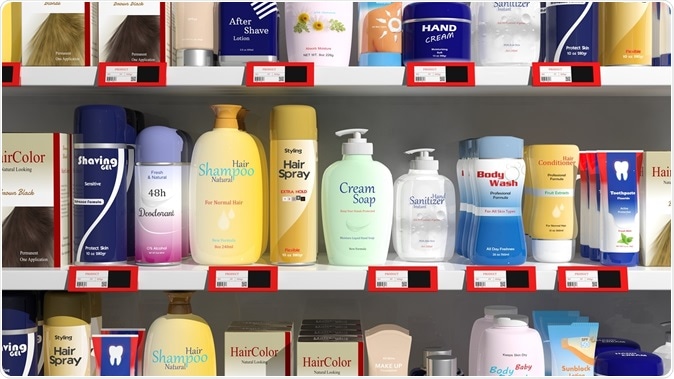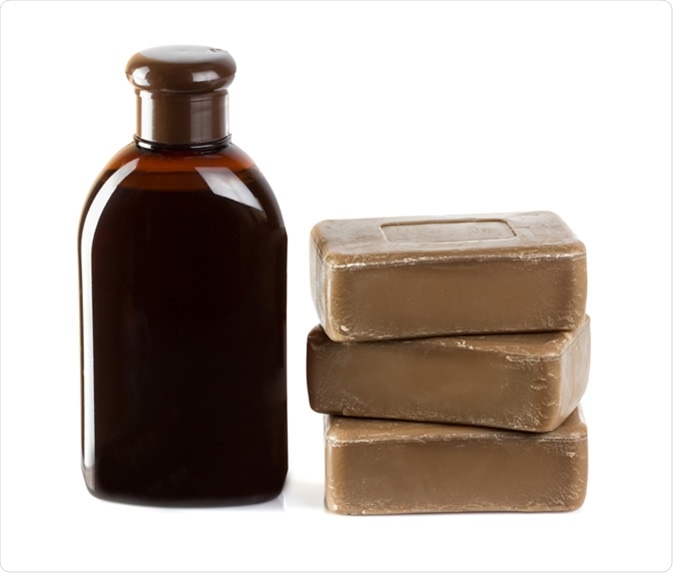The global cosmetic industry is expected to hit USD 863 billion by 2024, according to reports. Skincare, perfumes, hair care, toiletries & deodorants, and oral cosmetics are the key product categories of the cosmetic sector. Skincare products make up a whopping 36% of the global market and hair care an additional 23%.

Personal care products. Image Credit: Gts / Shutterstock
Studies show that American women use an average of 12 cosmetic products and 16 face care products in a day, which translates to exposure to over 200 chemicals in a day. What the increasingly beauty conscious global population doesn’t understand is cosmetics and personal care products for daily use by women are packed with loads of chemicals that are very harmful to human health. The US FDA has approved over 12,000 chemicals for use in the US cosmetics and personal care industry and research suggests that these chemicals cause many health problems ranging from allergies and infertility to cancer.
According to US government data, although overall cancer rates have come down recently, certain types of cancer such as liver and skin cancer are on the rise. Also, cancer rates in women have remained stable since 2008 while that among men has shown decline.
Consumer health advocates have been warning about the harmful effects of using these chemical-laden personal care products for years now. There is mounting evidence that suggests that these products are causing worrying disease trends in users, especially women.
Chemicals like formaldehyde (used in some keratin hair treatments, soaps and nail polish), coal tar (found in some shampoos and hair dyes), and heavy metals such as lead (found in clay-based products and lip sticks) are all carcinogens. Apart from these, medical experts are now worried that some chemicals used in cosmetics could be causing early onset of puberty in girls who use them. Girls as young as 8 and 9 years are developing pubic hair and breasts and the evidence suggesting unsafe chemicals in cosmetic products could be the reason behind this is overwhelming.

Birch coal tar soap and shampoo. Image Credit: SimpleName / Shutterstock
Chemicals such as phenols, parabens, and phthalates are widely used in household products such as scented deodorants, soaps, shampoos, perfumes, cosmetics, hairsprays, skin care products, lipsticks and nail polish. They are called endocrine-disrupting chemicals.
What are endocrine disruptors and how do they work?
Endocrine-disrupting chemicals interfere with our endocrine system and cause adverse reproductive, developmental, neurological, and immune effects. Exposure to these chemicals may result in lowered fertility, increased risk of endometriosis, and some types of cancers.
Studies show that endocrine disruptors may pose a greater threat during prenatal and early postnatal development, which is when organs and neural systems form.
Endocrine disruptors work in many ways. They partly or fully mimic hormones such as estrogen, called the female sex hormone, and also thyroid hormones, causing overstimulation. These chemicals can also bind to the cell’s hormone receptors, thus blocking the hormone from binding. This results in signal failure and affects the body’s response to the signal. Endocrine disruptors can also interfere with the production of natural hormones or their receptors by manipulating their metabolism in the liver.
Thus, when absorbed in the body, an endocrine disruptor can decrease or increase normal hormone levels thus causing major health issues over time.
What does research say?
A collaborative study by University of California and Centers for Disease Control and Prevention (CDC) representatives found that exposure to chemicals such as parabens, phenols, and phthalates in cosmetics was directly linked to early onset of puberty among girls. However, since these chemicals mostly mimic female hormones, boys were not affected much.
Of these chemicals, diethyl phthalate, used in fragrance, and triclosan, used as an antibacterial agent in some soaps and toothpastes, had more significant adverse effects than others. Girls with higher levels of parabens in their bodies at 9 years attained puberty earlier.
Earlier puberty in girls affects their behavior as teenagers and makes them more prone to mental health issues. More importantly, early onset of puberty increases breast and ovarian cancer risk in these girls in the long term, which makes this a very crucial issue that needs to be addressed without further delay.
Further Reading